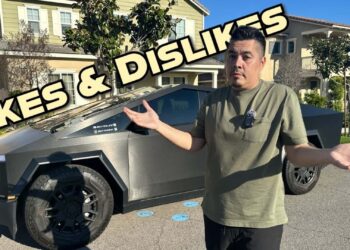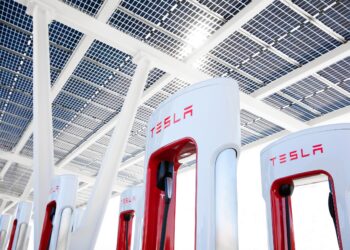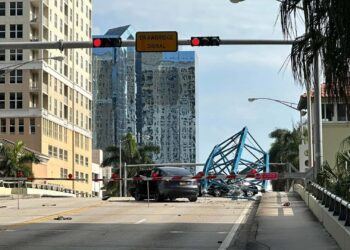
At least one Tesla Cybertruck has endured some Al Capone-style bulletproof testing, CEO Elon Musk claimed last week on X, after a video emerged where the truck looked like it had been pelted with bullets from a 1920s submachine gun. But take the Tesla head honcho’s hyperbolic Twitter rants with a grain of salt; the Tommy Gun isn’t cut out for the job but plenty of modern weapons might be, a firearms expert told InsideEVs.
Before we look at how the Cybertruck holds up under some apparent century-old ballistics testing, here’s what transpired last week: A member of the Tesla Owners Silicon Valley group on X spotted a Cybertruck rolling down a California highway with dozens of bullet marks on its driver’s side stainless steel exterior. Musk responded to the spy video, as he often does, saying that the Tesla team had discharged an “entire drum magazine of a Tommy gun” into the driver’s door. Notably, none of the bullets had penetrated the cabin. We should note that emptying an entire drum from a Tommy gun is not as easy as it sounds since the drum is notorious for misfiring, or rather not firing at all without repeatedly pulling the bolt back when it “jams.”
It has long been claimed that the upcoming Cybertruck is “bulletproof,” so much so that Musk attempted to demonstrate its durability during its 2019 debut only to have a window shatter instead.
So while we don’t know exactly what happened with this Cybertruck – or even why the Tesla team might use a Tommy Gun instead of a more modern firearm – one expert urged skepticism here.
“The size of the impact marks suggests it’s a Thompson .45 Auto machine gun,” said Jay Jarvis of Atlanta-based Arma Forensics, a firm that specializes in ballistics and firearms analysis. “I do not see any penetration but keep in mind the .45 Auto has a muzzle velocity of less than 1,000 feet per second. I would have rather seen them shoot it with a .223/5.56mm [bullet diameter inches/mm] or 7.62x39mm [bullet diameter x cartridge length] as these are more common than the Tommy Gun.” Jarvis is right; while the Tommy Gun probably makes for a fun prop, it’s awfully outdated compared to modern weapons.
“I would expect higher velocity rifle bullets, especially armor-piercing bullets, to penetrate this steel,” Jarvis said. As per one website, a .223 bullet could have a muzzle velocity – the speed at which the bullet leaves the muzzle of a gun – of over three times that of the Tommy Gun.
Another gun owner showcased on YouTube how bullets penetrated a type of steel that he claimed was close in specification to the one used on the Cybertruck. He carried the sheet of steel into the woods and fired several rounds at it with different guns and rifles. A 9-millimeter pistol bullet only dented the steel, but an AR 15 (.223×75) left a gaping hole in it.
I’m no gun expert, and Tesla’s test seems to offer initial indications that the Cybertruck may be resistant to bullets, but it falls short of the “impenetrable” title the brand has advertised on multiple occasions. It seems as though rounds more powerful than 9mm, especially those fired from rifles (which have higher velocities and a more pointed profile), can penetrate the Cybertruck’s steel, albeit by varying degrees. (None of this is surprising, obviously; making a car “bulletproof” is hardly ever a focus from any automaker, with the exception of security-focused vehicles.)
As a reminder, the electric truck’s exterior comprises “ultra hard 30x cold-rolled stainless steel.” As per the Society of Automotive Engineers (SAE), typical steel door panels are on the order of 0.7-1 millimeter thick, while the Cybertruck’s corrosion-resistant sheet metal is 3 mm thick.
At the 2019 unveiling event, Tesla’s chief designer Franz von Holzhausen threw a steel ball at the Cybertruck’s armored glass. Instead of deflecting the ball, the window embarrassingly broke. Two years later, Tesla patented a multi-layered armored glass that can apparently withstand a two-joule impact with only a ten percent rate of failure.
Tesla said during its Q3 earnings call that Cybertruck deliveries will begin on November 30, with an estimated initial annual production capacity of over 125,000 units. Although Musk urged the audience to temper their expectations for the Cybertruck and later added that the company dug its own grave with the truck, indicating that its development and production journey was a nightmare.
Only time will tell whether people will be lured to the Cybertruck thanks to its “apocalypse defense technology,” or if its other capabilities will be more compelling instead.









